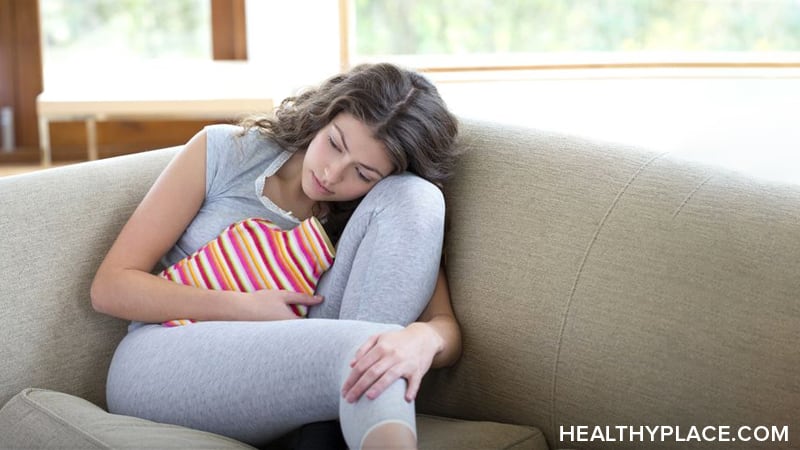Depression and PMS: Why It Happens, How to Ease the Symptoms

Depression and premenstrual syndrome (PMS) is a legitimately unpleasant experience. The thoughts, feelings, and behaviors aren’t something to be glibly and annoyingly dismissed as “just that time of the month.” Rather, they are biologically connected to the menstrual cycle. If you’ve been frustrated by your monthly mood disturbances, keep reading. You’ll learn about the real connection between depression and PMS as well as how to ease your symptoms.
If you experience depression associated with PMS, you’re among the company of many women. Approximately 75 percent of women of childbearing age experience PMS, and about half of the women who receive treatment for PMS also report having depression symptoms during the two weeks leading up to their period (Tantry, 2019). Additionally, some women who live with major depressive disorder (MDD) experience a worsening of their depression before menstruation.
Depression symptoms that can begin or intensify about mid-month include:
- Intense sadness
- Crying spells or easily becoming teary
- Irritability or anger
- Fatigue
- Sleep changes, either more or less
- Appetite changes, eating too much or too little
- Absentmindedness or forgetfulness
- Lack of interest in activities usually enjoyed
Experiencing depression symptoms every month before your period becomes disheartening and life-disrupting. While the exact cause and mechanisms are still unknown and being studied, researchers have discovered a partial explanation. The reason is related to fluctuations in body chemistry.
What Causes Depression and PMS?
PMS-related depression typically begins about two weeks before menstruation because that’s when ovulation occurs. When the body releases an ovum, or egg, there’s a drop in the levels of two key hormones: estrogen and progesterone. The change in these chemical levels directly affects the levels of the neurotransmitter serotonin, causing it to decrease, too.
Low levels of serotonin are associated with emotional changes like sadness and irritability. Lack of serotonin is also linked to sleep difficulties and food cravings, two other prominent symptoms of depression PMS.
The occurrence of negative symptoms after ovulation is natural. That doesn’t mean, however, that you have to suffer from depression for two weeks every month. You can do things to ease your symptoms.
Easing Your Symptoms of Depression and PMS
Because depression during PMS is biological, you can impact your body in healthy ways to decrease your symptoms. It starts by knowing what makes depression PMS worse. Certain things are known to exacerbate depression during your menstrual cycle:
- Poor nutrition
- Lack of exercise
- Poor quality of sleep
- Stress
- Alcohol
- Smoking
Targeting these areas will help reduce symptoms. If you smoke, work on quitting. Minimize alcohol consumption or avoid it altogether. Beyond this, you can do things to enhance your healthy lifestyle.
Track your symptoms. Recording your symptoms in a mood journal, chart, or mood tracker app can help you understand when you experience mood changes and what you think and feel. This deeper awareness can help you develop perspective and motivation to take positive action. When you see that your feelings and thoughts are related to hormonal fluctuations and thus come and go, you can distance yourself from them, lessening their impact because you know they’re neither realistic or permanent.
Take charge of your nutrition. PMS cravings can lead to eating the types of food that makes depression worse. Limit sugary and salty foods, foods high in saturated fat, and caffeinated beverages, and replace them with whole grains, fruits, vegetables, nuts, and seeds. In particular, eat foods high in calcium (dairy and green, leafy vegetables), vitamin B-6 (fish, poultry, fruit, and fortified cereals), and magnesium (almonds, peanuts, and green, leafy vegetables) to give your body the nutrients it needs after ovulation. Taking supplements with these vitamins and minerals can help, too.
Make healthy lifestyle choices. Daily exercise staves off depression symptoms. Spend about 30 minutes being active, doing something you enjoy (or used to enjoy) to keep moods up and positively impact neurochemicals. Exercise also improves sleep, which is another important lifestyle component. Getting 7-8 hours of quality sleep each night can ease depression PMS. Stress management is paramount, too. Taking time to relax, enjoy the company of loved ones, and engage in hobbies is a proven way to help depression and PMS.
Talk to your doctor about medication. Sometimes, the above actions don’t do enough on their own to ease symptoms. When that happens, antidepressants that ease PMS might be in order. A type of antidepressant known as selective serotonin reuptake inhibitors, or SSRIs like Celexa (citalopram), Prozac (fluoxetine), Zoloft (sertraline) and others, keep serotonin levels up in the brain, which reduces depression symptoms. Also, some people find hormonal birth control pills to be helpful. Talk with your doctor to see if medication might help reduce your symptoms.
Depression and PMS can reduce the quality of your life, but you can ease the symptoms and reclaim your mental health and wellbeing.
APA Reference
Peterson, T.
(2022, January 3). Depression and PMS: Why It Happens, How to Ease the Symptoms, HealthyPlace. Retrieved
on 2025, November 27 from https://www.healthyplace.com/depression/women/depression-and-pms-why-it-happens-how-to-ease-the-symptoms



